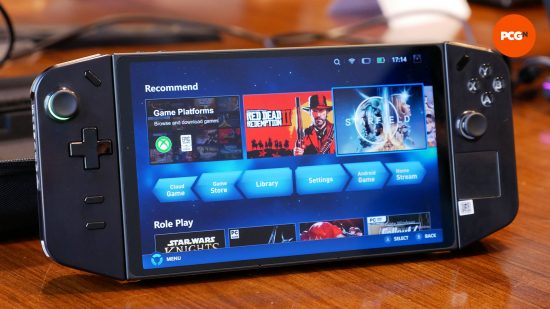Few could’ve predicted just how quickly the gaming handheld market would grow, following the launch of Valve’s Steam Deck. Seemingly a random pie-in-the-sky Valve hardware bet, suddenly we now have a host of handheld gaming PCs, with the latest being the biggest yet: the Lenovo Legion Go. I got to spend an hour or so with the device at a preview event to find out whether its massive 8.8-inch screen and detachable controllers make it the best gaming handheld so far, or if it’s due to a round of decimation. Read on for our full Lenovo Legion Go hands-on preview.
Why you can trust our advice ✔ At PCGamesN, our experts spend hours testing hardware and reviewing games and VPNs. We share honest, unbiased opinions to help you buy the best. Find out how we test.
Lenovo Legion Go design
In the hand, the Legion Go is an absolute bruiser of a gaming handheld when compared to either the Steam Deck or Asus ROG Ally, and particularly when compared to even smaller units like the Nintendo Switch. Its 8.8-inch screen is, after all, nearly two inches wider than its main rivals, while the addition of detachable controls means these have to sit fully outside of the tablet/screen section of the device, rather than being able to wrap around the back of the screen.
As well as being big, the Legion Go also weighs the better part of 200g (7oz) heavier than the Ally and Steam Deck. However, you don’t necessarily notice this, as the larger tablet and sizeable controls mean the device sits comfortably in your hands – it doesn’t feel like a dense, unbalanced, or awkward device to hold.
Longer gaming sessions may result in you feeling the extra weight a little more, but realistically, the inherent two-hand nature of these devices means most users won’t meaningfully notice the difference. Plus, for longer sessions, you can always pop the kickstand, unclip the controllers, and set the tablet down while you game – a feature that’s not present on either the Steam Deck or Ally.
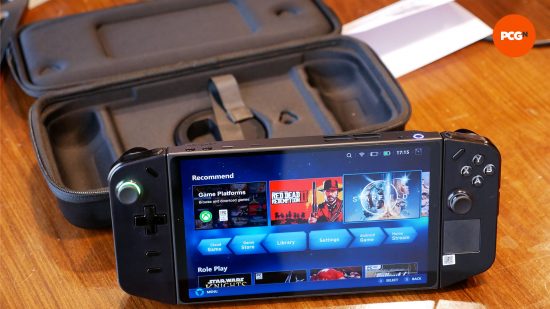
The main area where the Legion Go feels particularly unwieldy is when being used as a tablet, with the controllers removed. In theory, it makes for a compact, versatile device that can double as a tablet as well as a gaming handheld, but it’s very thick and the lack of the standard protective, easy-to-hold cases most folks use with regular tablets means it feels a bit precarious. It will be fine for watching videos in bed or on the sofa – and of course, the kickstand means you can set it down and watch from afar – but you wouldn’t want to just hold the Legion Go one-handed on the train.
As for how the Legion Go looks, it’s a fairly humdrum unit. The main tablet section has a metal back, and there are some reasonable quality black plastics used throughout, but there’s little flair to the design. It’s black, with a little more black, and some more black to boot. The main stylistic additions are the rings of RGB lighting around the thumbsticks, the color and brightness of which are easy to control with Lenovo’s onboard software.
Lenovo Legion Go controllers
The Legion Go’s controllers attach to the sides of the tablet unit with an impressively secure yet quick-release system. A button on the back of each controller unlocks them, then a short slide-down motion unclips them – there’s none of the long, sliding-off of the Switch controllers. It’s impossible to say from an hour or so with the device if these clips will truly remain strong enough over the years, but there was no obvious wobble to the mechanism when attached – it’s an impressive piece of engineering.
Each controller is charged via pins on its side, with no removable batteries or means of external charging, which is a little limiting. It may be a niche scenario, but if a controller runs out of juice when you’re using it detached, you’re forced to reattach it, rather than plugging it in (or swapping batteries) and carrying on gaming.
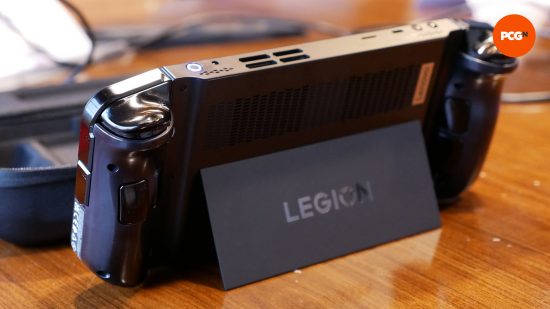
The controls themselves are plentiful. On the left side, there’s a thumbstick, a D-pad, three small face buttons (for bringing up menus and so on), a bumper button, an analog trigger, and two rear buttons as well. Meanwhile, the right controller also has a thumbstick, along with ABXY buttons, a small trackpad, two side bumpers, an analog trigger, and a single rear button.
All the controls feel well-positioned, at least for my mid/large-sized hands (20cm long from wrist to middle fingertip). The rear buttons feel a little cramped, but by and large, it feels like the Go will suit a decent range of hand sizes.
This handheld also has a potentially neat party trick: detach the right controller, flick a switch on its underside, and mount it in the included mini stand and you can use it as a mouse. Lenovo describes this feature as the ‘FPS’ mode, but given the way the controller stands bolt upright it doesn’t seem ideal for use as an FPS gaming mouse. Sadly, the unit Lenovo had for testing also had a faulty right controller, which along with greatly limiting my options for experiencing gaming on the handheld, meant I couldn’t try the mouse feature.
Other buttons include the power and volume buttons on the top edge of the tablet. The thumbsticks also use hall effect sensors, to prevent them from suffering from stick drift, plus they have removable caps. Each control also offers gyro control – like VR headset controllers – but again I wasn’t able to test this feature.
Lenovo Legion Go connections
As it’s essentially a Windows tablet, the Legion Go has plenty of potential for being used for more than just gaming, so it needs a few connection options. On the top and bottom of the tablet are USB-C ports that can charge the device and pass video out to connected monitors.
This was demonstrated on a huge 45-inch gaming monitor and the tablet had no trouble running at this resolution (once we’d navigated Windows’ screen settings). You won’t have much fun gaming at this resolution, but it’s great for work and video.
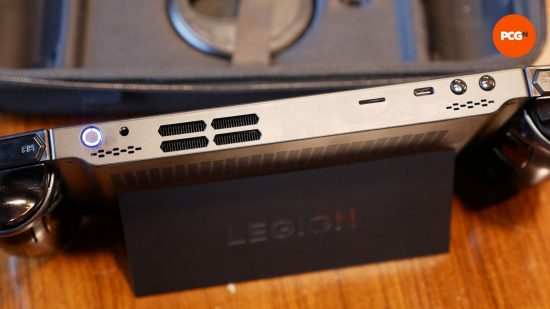
What’s more, the USB-C ports can be used with external GPUs, so you can bolster the tablet’s graphics power. At least, that’s the theory – the Lenovo representatives on hand said it should be possible but they hadn’t tried it themselves.
Other ports include a standard headphone jack and there’s a microSD slot for expanding the tablet’s storage by up to 2TB. You also get Bluetooth and WiFi built-in.
Lenovo Legion Go screen
The standout feature of the Legion Go is of course its screen. Measuring 8.8 inches from corner to corner, and with a massive 2,560 x 1,600 resolution, it dwarfs the Steam Deck and ROG Ally screens for both size and resolution.
This extra space and sharpness are visible too. For anyone who partially hoped handhelds such as this one could also replace a tablet for most web browsing/email/video use, the Steam Deck flatly didn’t deliver that experience. The ROG Ally takes a big step forward with its higher 1080p resolution, but its 7-inch screen still feels limiting. The Legion Go, though, really feels like a proper tablet, at least if you ignore its thickness.
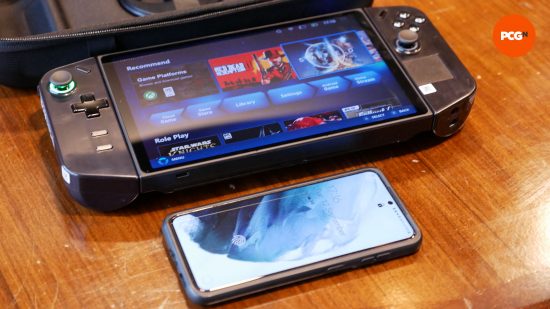
The screen is not just large and pixel-packed but high quality too, with 98% DCI-P3 color space coverage for HDR-like color fidelity. The mini LED panel looked to have excellent contrast too, in the sunlit room in which we were testing it. Games and video looked fantastic on it.
You can of course run the screen at a lower resolution, with Lenovo’s software having quick access to converting the tablet to run at a Steam Deck-matching resolution of 1,280 x 800 or 1,920 x 1,200. Notably, the screen’s ratio of height to width is the same here as on the Steam Deck, rather than the slightly wider ratio of the Ally, which runs at 1,920 x 1,080 – the taller view is better for basically anything outside of gaming and video.
The other big feature of this screen is its 144Hz refresh rate. The step up from the 60Hz of the Steam Deck is a huge upgrade – even just scrolling feels so much smoother. That said, the step up from the 120Hz of the ROG Ally is all but pointless. We’re not talking about playing twitchy esports FPS titles on a device such as this one, so the extra 24Hz doesn’t add much – we’d be inclined to lock game refresh rates at a lower setting to reduce GPU load instead.
Lenovo Legion Go gaming performance
The biggest question mark over all these handheld devices is their raw gaming performance, and that’s no different for the Legion Go. It uses the same AMD Z1 Extreme processor as the ROG Ally, which has already proven to deliver considerably faster performance than the Steam Deck’s older processor. However, the step up in resolution here puts a much bigger burden on that chip.
Sadly, Lenovo hadn’t loaded up the demo model of this device with any games other than Rocket League and again the problems with the right controller meant we couldn’t control the game properly. However, we were able to observe via the game’s in-built FPS tracker that it was running at around 65fps at full resolution, and with most in-game details set to High and no upscaling being used. It looked great and felt smooth.
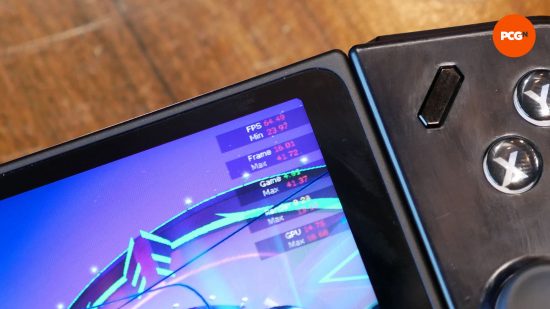
Cranked down to Steam Deck-matching resolution, the game ran at a high enough frame rate to max out the screen’s 144Hz refresh rate. Rocket League isn’t a demanding game, but plenty of other more demanding games should at least be playable, even if you do have to lower the resolution and crank up resolution scaling using AMD FSR. Notably, this device didn’t secretly have an early version of AMD FSR 3, so there was no frame generation tech available.
Lenovo Legion Go heat and noise
With all that processing power, it’s no surprise the Legion Go can run fairly hot, and there was a noticeable woosh of air blowing out of its top-edge air vents during intensive gaming moments. Because of our location, next to a noisy street with the windows open, it was difficult to get a full sense of the device’s loudness when the fan was spinning up, but it certainly didn’t have an obvious distracting high-pitched whine or rattle.
Lenovo Legion Go battery life
The Go has a larger 49.2Whr battery, which is better than the 40Hr batteries of its rivals, but this extra capacity is likely to be offset by the larger screen and more powerful processor. Lenovo reckons the device will provide around two hours of use when gaming, and up to around eight hours for other uses.
To aid in balancing performance and battery life, Lenovo’s software has quick access to several thermal profiles that can drop the tablet from running at its default 32W mode down to 21W or even 8W modes. Alternatively, when plugged in you can run it at 42W.
Lenovo Space software
Lenovo has loaded up the Legion Go with its Legion Space software, which provides the default interface for interacting with the device. Here you access the various settings described above, along with many more general device settings available. Plus, there’s access to game stores. These can be added at the touch of a button, making it easy to browse the store libraries.
This slick software is easy to navigate whether you’re using the D-pads, thumbstick, or touchscreen. You can quickly get back to the Windows interface just by swiping up from the bottom of the screen or opt to have the device boot to Space or just to Windows.
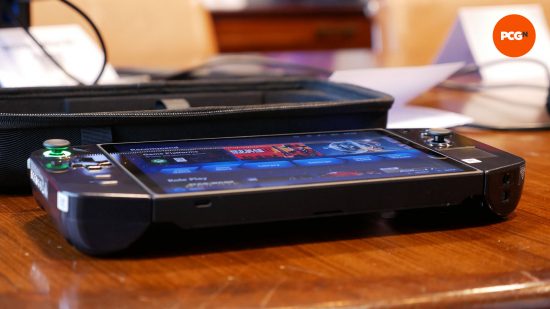
Lenovo Legion Go first impressions
The biggest takeaway from our initial time with the Lenogo Legion Go is that it largely delivers on the handful of key features you might expect from it. The screen does make it feel like a proper hybrid between a purely dedicated gaming handheld and a premium tablet. Ironically, it’s not necessarily gaming that benefits most here, but neither does the screen lessen the gaming experience – it looks sharp and feels smooth.
Meanwhile, the detachable controllers and kickstand make this handheld feel versatile yet still portable. Used just as a tablet, it’s too thick and unwieldy to replace a dedicated tablet, but the detachable controls do make it easier to pack and I could certainly see some users being happy with the Legion Go as their main travel device.
For gaming, the Legion Go also delivered an impressive performance, considering it was running at such a high resolution, even if Rocket League wasn’t much of a challenge. Much more demanding testing will be needed when we write our full review, but there are going to be plenty of games that will be a joy to play on this device.
For those purely after a gaming handheld, with no consideration for a more general portable device, the Steam Deck is likely to remain the top choice, especially if it gets a screen resolution and processor upgrade. However, if you’re tempted by a slightly more versatile device, the Legion Go makes a compelling argument.
Interesting in getting the best handheld gaming PC? Check out our full Steam Deck review and Asus ROG Ally review for a deeper dive into those devices.
